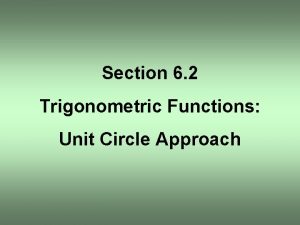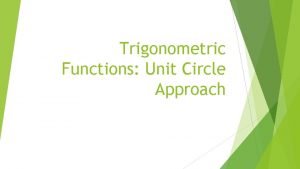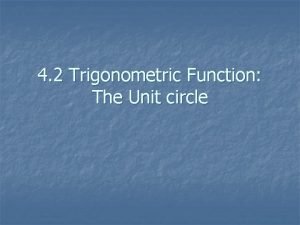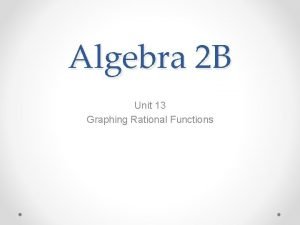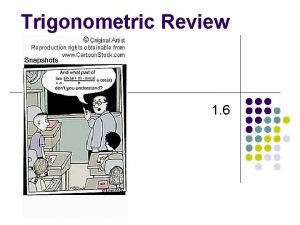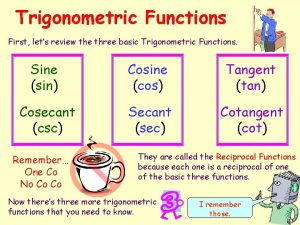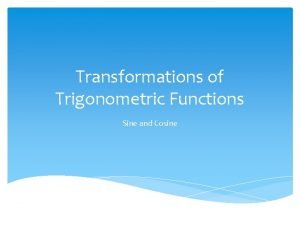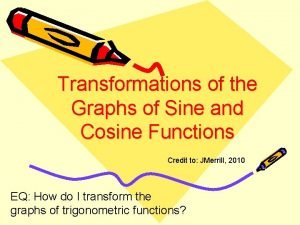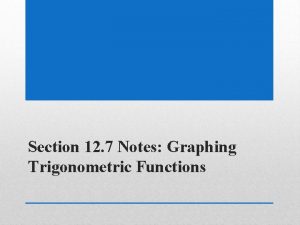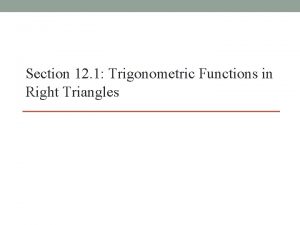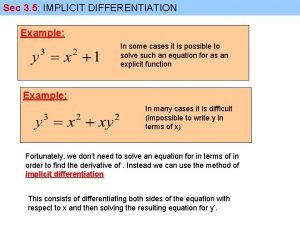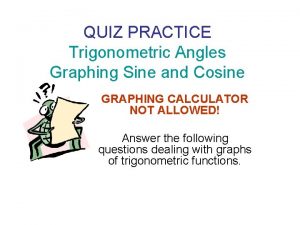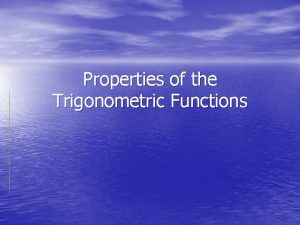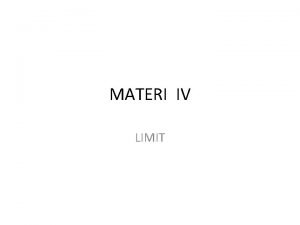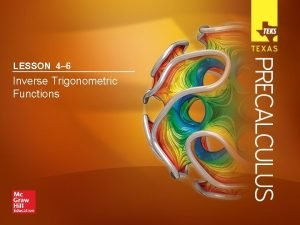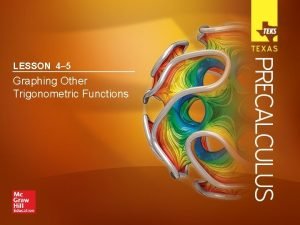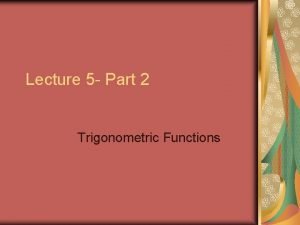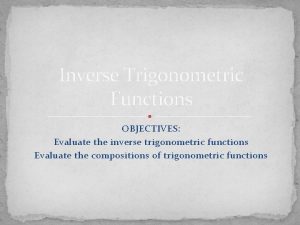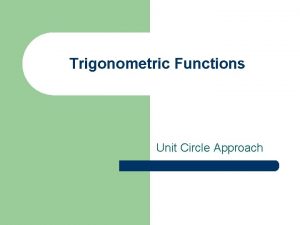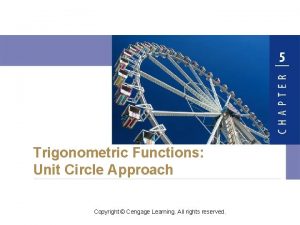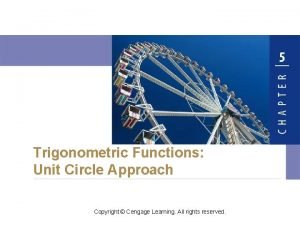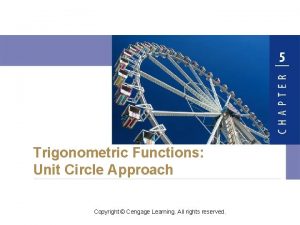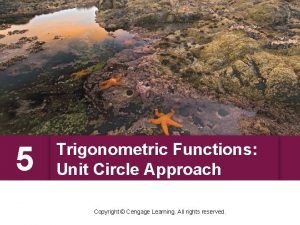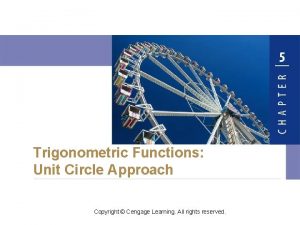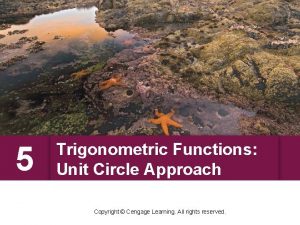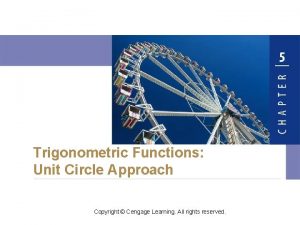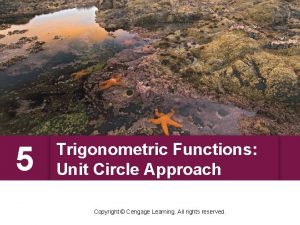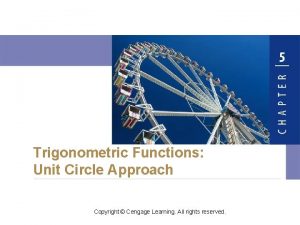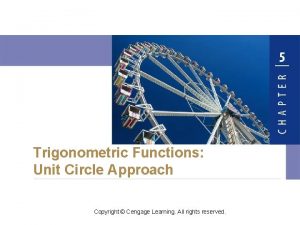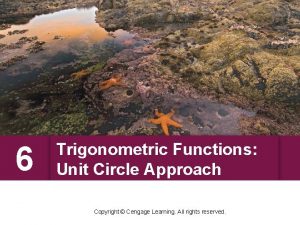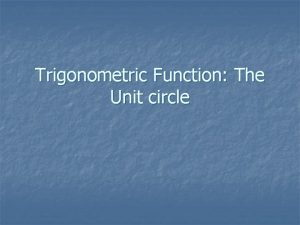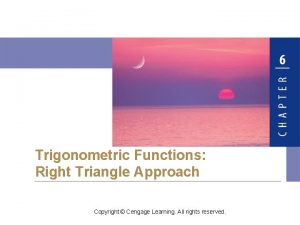5 Trigonometric Functions Unit Circle Approach Copyright Cengage



















- Slides: 19

5 Trigonometric Functions: Unit Circle Approach Copyright © Cengage Learning. All rights reserved.

The Unit Circle In this section we explore some properties of the circle of radius 1 centered at the origin. The set of points at a distance 1 from the origin is a circle of radius 1 (see Figure 1). The unit circle Figure 1 2

Example 1 – A Point on the Unit Circle Show that the point P is on the unit circle. 3

Terminal Points on the Unit Circle 4

Terminal Points on the Unit Circle Suppose t is a real number. If t 0, let’s mark off a distance t along the unit circle, starting at the point (1, 0) and moving in a counterclockwise direction. If t < 0, we mark off a distance | t | in a clockwise direction (Figure 2). (a) Terminal point P(x, y) determined by t > 0 (b) Terminal point P(x, y) determined by t < 0 Figure 2 5

Terminal Points on the Unit Circle In this way we arrive at a point P(x, y) on the unit circle. The point P(x, y) obtained in this way is called the terminal point determined by the real number t. The circumference of the unit circle is C = 2 (1) = 2. So if a point starts at (1, 0) and moves counterclockwise all the way around the unit circle and returns to (1, 0), it travels a distance of 2. To move halfway around the circle, it travels a distance of (2 ) = . To move a quarter of the distance around the circle, it travels a distance of (2 ) = /2. 6

Terminal Points on the Unit Circle Where does the point end up when it travels these distances along the circle? From Figure 3 we see, for example, that when it travels a distance of starting at (1, 0), its terminal point is (– 1, 0). Terminal points determined by t = , , , and 2 Figure 3 7

Example 3 – Finding Terminal Points Find the coordinates of the terminal point on the unit circle determined by each real number t. (a) t = 3 (b) t = – (c) t = – 8

Terminal Points on the Unit Circle 9

Terminal Points on the Unit Circle Similar methods can be used to find the terminal points determined by t = /6 and t = /3. Table 1 and Figure 6 give the terminal points for some special values of t. Table 1 Figure 6 10

Example 4 – Finding Terminal Points Using symmetry, find the terminal point determined by each given real number t. (a) t = (b) t = (c) t = 11

The Reference Number 12

The Reference Number To find a terminal point in any quadrant, we need only know the “corresponding” terminal point in the first quadrant. We use the idea of the reference number to help us find terminal points. 13

The Reference Number Figure 8 shows that to find the reference number t, it’s helpful to know the quadrant in which the terminal point determined by t lies. The reference number t for t Figure 8 14

Example 5 – Finding Reference Numbers Find the reference number for each value of t. (a) t = (b) t = (c) t = (d) t = 5. 80 15

The Reference Number 16

Example 6 – Using Reference Numbers to Find Terminal Points Using reference numbers, find the terminal point determined by each given realnumber t. (a) t = (b) t = (c) t = 17

The Reference Number Since the circumference of the unit circle is 2 , the terminal point determined by t is the same as that determined by t + 2 or t – 2. In general, we can add or subtract 2 any number of times without changing the terminal point determined by t. We use this observation in the next example to find terminal points for large t. 18

Example 7 – Finding the Terminal Point for Large t Find the terminal point determined by 19
 Trigonometric functions unit circle approach
Trigonometric functions unit circle approach Trigonometric functions unit circle approach
Trigonometric functions unit circle approach Unit circle radians
Unit circle radians Cengage chapter 7
Cengage chapter 7 Algebra 2b unit 3 trigonometry
Algebra 2b unit 3 trigonometry Cofunction identites
Cofunction identites Three basic trigonometric functions
Three basic trigonometric functions Partner of sine and cosine
Partner of sine and cosine How to find the period of a cosine function
How to find the period of a cosine function 12-7 graphing trigonometric functions answers
12-7 graphing trigonometric functions answers 12-1 trigonometric functions in right triangles
12-1 trigonometric functions in right triangles Implicit differention
Implicit differention Graphing sine and cosine functions quiz
Graphing sine and cosine functions quiz Domain and range of trigonometric function
Domain and range of trigonometric function Limit of trigonometric functions examples
Limit of trigonometric functions examples Technology applications teks
Technology applications teks 4-5 practice graphing other trigonometric functions
4-5 practice graphing other trigonometric functions Parts of trigonometric functions
Parts of trigonometric functions Domain and range of trigonometric functions
Domain and range of trigonometric functions Derivative inverse trig
Derivative inverse trig
